A Detailed Analysis of HRM Practices in Tourism and Aviation
VerifiedAdded on 2022/08/27
|7
|1380
|14
Report
AI Summary
This report provides an analysis of Human Resource Management (HRM) practices within the tourism and aviation industries. It begins by evaluating the recruitment and selection processes, highlighting the evolution of these practices and comparing the approaches used by airlines and tourism organizations. The report details the specific steps involved in the recruitment of aviation and tourism industry employees, including aptitude tests, English proficiency assessments, and interviews. Furthermore, it explores the use of HR planning techniques, such as the analysis of work operations, job flexibility, and demand forecasting, and their impact on customer satisfaction and service quality. The report also discusses the application of social demand and supply-demand approaches in determining manpower needs and the use of the rate of return approach for financial planning. It concludes by recommending the application of these techniques for better hiring decisions and improved employee turnover rates. The report references relevant academic sources to support its findings.
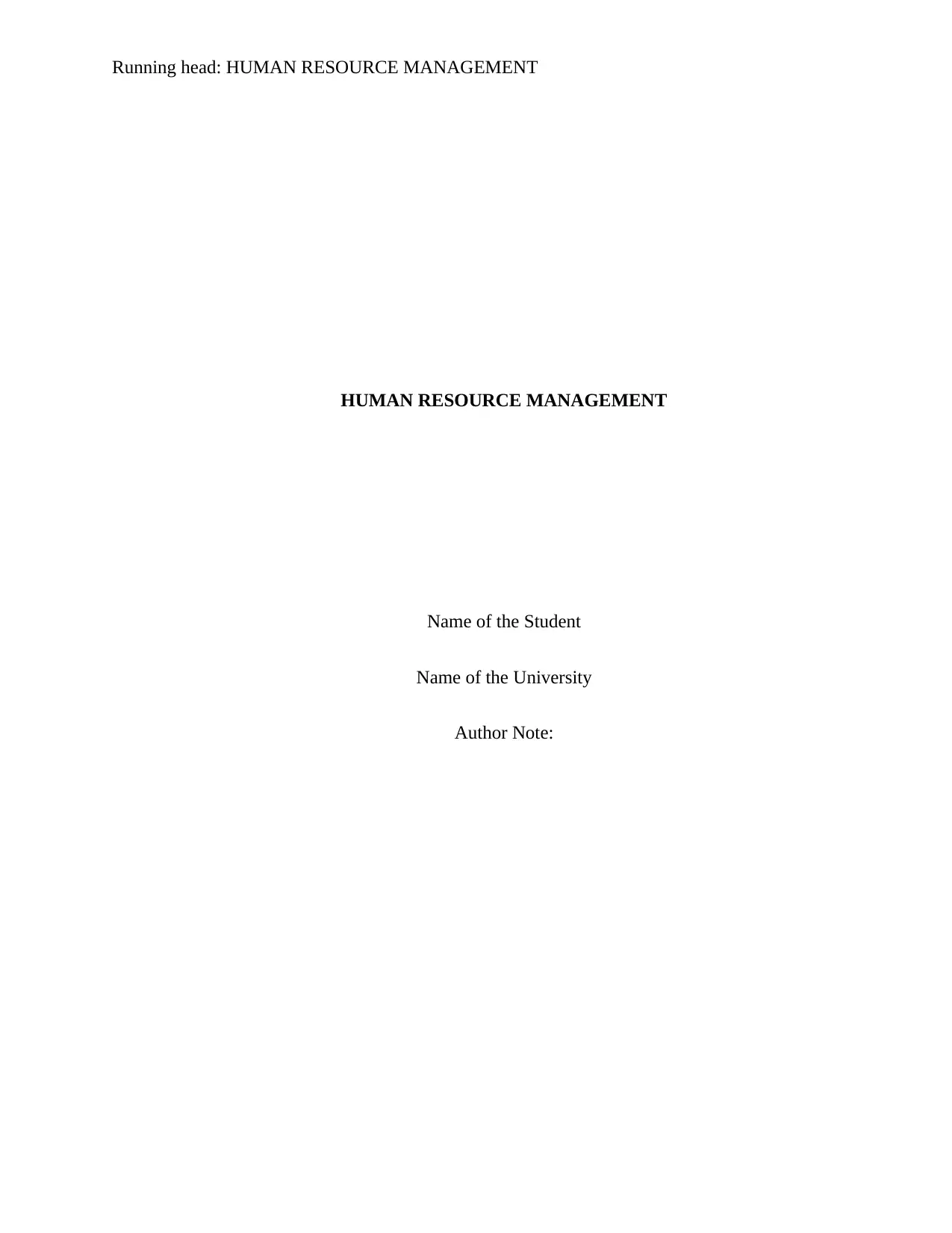
Running head: HUMAN RESOURCE MANAGEMENT
HUMAN RESOURCE MANAGEMENT
Name of the Student
Name of the University
Author Note:
HUMAN RESOURCE MANAGEMENT
Name of the Student
Name of the University
Author Note:
Paraphrase This Document
Need a fresh take? Get an instant paraphrase of this document with our AI Paraphraser
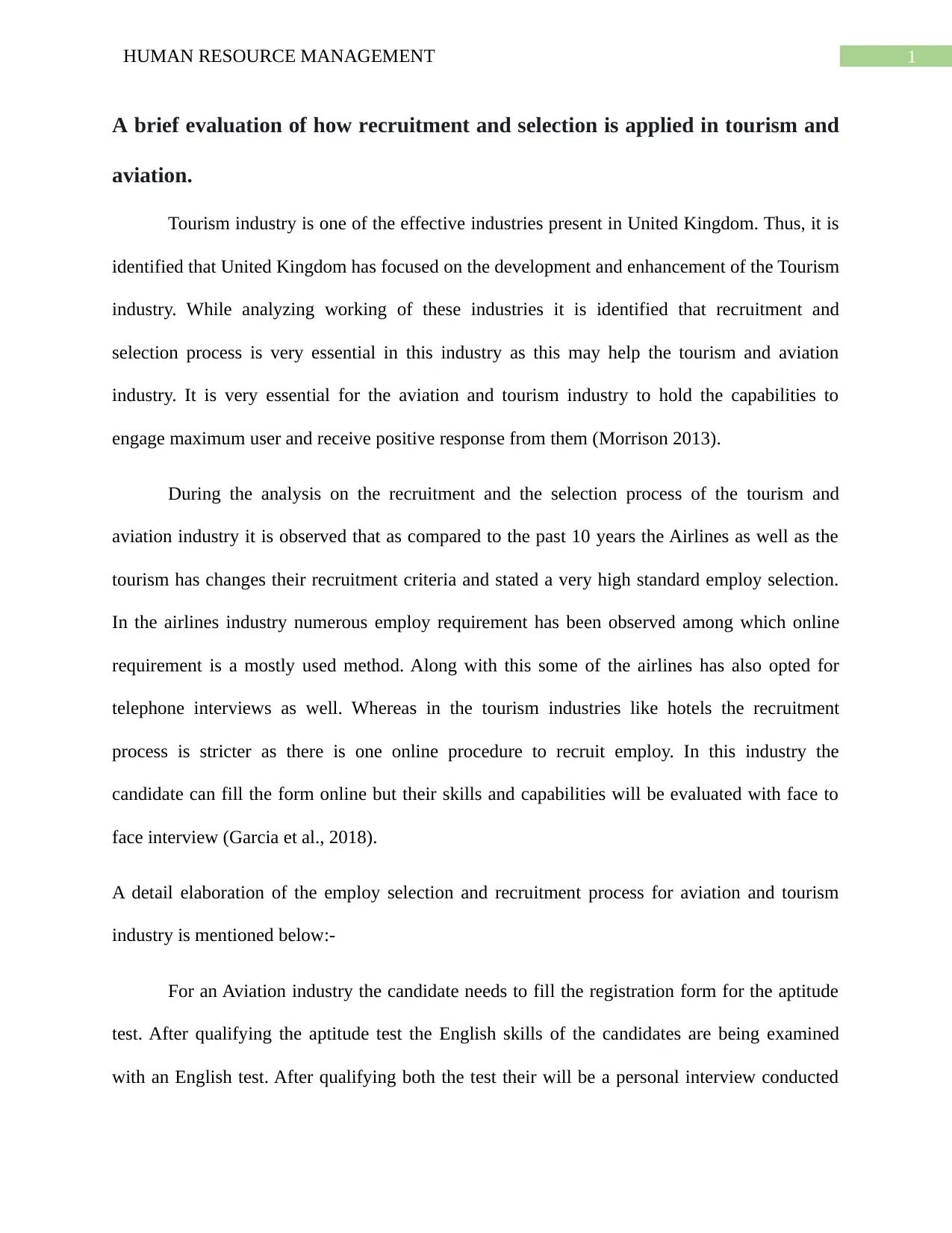
1HUMAN RESOURCE MANAGEMENT
A brief evaluation of how recruitment and selection is applied in tourism and
aviation.
Tourism industry is one of the effective industries present in United Kingdom. Thus, it is
identified that United Kingdom has focused on the development and enhancement of the Tourism
industry. While analyzing working of these industries it is identified that recruitment and
selection process is very essential in this industry as this may help the tourism and aviation
industry. It is very essential for the aviation and tourism industry to hold the capabilities to
engage maximum user and receive positive response from them (Morrison 2013).
During the analysis on the recruitment and the selection process of the tourism and
aviation industry it is observed that as compared to the past 10 years the Airlines as well as the
tourism has changes their recruitment criteria and stated a very high standard employ selection.
In the airlines industry numerous employ requirement has been observed among which online
requirement is a mostly used method. Along with this some of the airlines has also opted for
telephone interviews as well. Whereas in the tourism industries like hotels the recruitment
process is stricter as there is one online procedure to recruit employ. In this industry the
candidate can fill the form online but their skills and capabilities will be evaluated with face to
face interview (Garcia et al., 2018).
A detail elaboration of the employ selection and recruitment process for aviation and tourism
industry is mentioned below:-
For an Aviation industry the candidate needs to fill the registration form for the aptitude
test. After qualifying the aptitude test the English skills of the candidates are being examined
with an English test. After qualifying both the test their will be a personal interview conducted
A brief evaluation of how recruitment and selection is applied in tourism and
aviation.
Tourism industry is one of the effective industries present in United Kingdom. Thus, it is
identified that United Kingdom has focused on the development and enhancement of the Tourism
industry. While analyzing working of these industries it is identified that recruitment and
selection process is very essential in this industry as this may help the tourism and aviation
industry. It is very essential for the aviation and tourism industry to hold the capabilities to
engage maximum user and receive positive response from them (Morrison 2013).
During the analysis on the recruitment and the selection process of the tourism and
aviation industry it is observed that as compared to the past 10 years the Airlines as well as the
tourism has changes their recruitment criteria and stated a very high standard employ selection.
In the airlines industry numerous employ requirement has been observed among which online
requirement is a mostly used method. Along with this some of the airlines has also opted for
telephone interviews as well. Whereas in the tourism industries like hotels the recruitment
process is stricter as there is one online procedure to recruit employ. In this industry the
candidate can fill the form online but their skills and capabilities will be evaluated with face to
face interview (Garcia et al., 2018).
A detail elaboration of the employ selection and recruitment process for aviation and tourism
industry is mentioned below:-
For an Aviation industry the candidate needs to fill the registration form for the aptitude
test. After qualifying the aptitude test the English skills of the candidates are being examined
with an English test. After qualifying both the test their will be a personal interview conducted

2HUMAN RESOURCE MANAGEMENT
by united aviation. Then the candidate will be send to the personal interview for their respective
organization.
In the tourism industry most of requirement process is initiated by departments of the
respected tourism organization. The requirement structure of tourism industry is consist of a
preliminary interview, then there is a selection test, after qualifying these stages there will be
employment interview, then a final evaluation will be conducted and then the department will
provide the final approval to the selected candidates (Hur et al. 2013).
After analyzing the recruitment process of Aviation industry and the tourism industry it is
identified that the employ recruitment and selection process of tourism industry is most effective
as followed by the selection process of tourism industry the skills of the candidates can be
effectively evaluated as this process consist of interviews in many stages. Whereas, the
recruitment process of aviation industry mostly depends on online examination.
Apart from these identification it can be stated that selection process of Aviation industry
has benefits too, in which it is observed that the online recruitment process reduces the physical
challenges as it is not essential for the candidate to be physically present at the recruitment
office. Along with this it also reduces the cost of the recruitment process that helps the recruiter
to save extra expenses with online recruitment process (Camilleri 2018).
A brief analysis of HR planning techniques and how these are used within the
tourism/aviation.
There are several human resource planning present that makes the planning process
easier. As the human resource department in every organization manages several activities for
which they need to list the appropriate procedure and policies. Thus, an effective HR planning is
by united aviation. Then the candidate will be send to the personal interview for their respective
organization.
In the tourism industry most of requirement process is initiated by departments of the
respected tourism organization. The requirement structure of tourism industry is consist of a
preliminary interview, then there is a selection test, after qualifying these stages there will be
employment interview, then a final evaluation will be conducted and then the department will
provide the final approval to the selected candidates (Hur et al. 2013).
After analyzing the recruitment process of Aviation industry and the tourism industry it is
identified that the employ recruitment and selection process of tourism industry is most effective
as followed by the selection process of tourism industry the skills of the candidates can be
effectively evaluated as this process consist of interviews in many stages. Whereas, the
recruitment process of aviation industry mostly depends on online examination.
Apart from these identification it can be stated that selection process of Aviation industry
has benefits too, in which it is observed that the online recruitment process reduces the physical
challenges as it is not essential for the candidate to be physically present at the recruitment
office. Along with this it also reduces the cost of the recruitment process that helps the recruiter
to save extra expenses with online recruitment process (Camilleri 2018).
A brief analysis of HR planning techniques and how these are used within the
tourism/aviation.
There are several human resource planning present that makes the planning process
easier. As the human resource department in every organization manages several activities for
which they need to list the appropriate procedure and policies. Thus, an effective HR planning is
⊘ This is a preview!⊘
Do you want full access?
Subscribe today to unlock all pages.

Trusted by 1+ million students worldwide

3HUMAN RESOURCE MANAGEMENT
required. While analyzing this aspect it has been identified that the human resource planning
techniques includes the Analysis of work operations, analysis on job flexibility, demand
forecasting as well as demand forecasting. Followed by this observation it is identified that the
tourism industry is highly focused on the customer satisfaction and service quality thus in this
industry human resource plays a major role that enhances the service quality as well as
productivity. As per the characteristics of the HR department it is also identified that in the
employment process HR planning plays a major role. While analyzing the HRP techniques in the
tourism industry it has been identified that they are mostly focused on the customer demand and
flexible working with the purpose to provide best services to its employs (Erkmen, Hancer and
Leong 2017).
Making allowance to this aspect it is identified that by utilizing the social demand
approach it analyses the demands to manpower and how these manpower may deliver their
desired services to its customers. Along with this since, tourism industry is one of the largest
industry thus, it is very essential to maintain balance between the demand and supply (Liu et al.,
2018). Here the supply demand approach works, which helps to determine the demand of labor.
Along with this the rate of return approach is also one of the most effective techniques for HR
planning into the tourism industry as it helps to calculate the net return by considering the annual
expenditure. As financial calculation is very essential in tourism industry that is mostly utilized
to calculate the net income of the industry (Kispal-Vitai and Wood 2018).
Considering the above discussion it is identified that in the tourism industry there is a
major influence of HR planning. As it is discussed earlier that social demand approach and the
rate of return techniques helps the HR to get a detail idea about the required man power into the
specific organization under the nominated industry by which the HR can structure its recruitment
required. While analyzing this aspect it has been identified that the human resource planning
techniques includes the Analysis of work operations, analysis on job flexibility, demand
forecasting as well as demand forecasting. Followed by this observation it is identified that the
tourism industry is highly focused on the customer satisfaction and service quality thus in this
industry human resource plays a major role that enhances the service quality as well as
productivity. As per the characteristics of the HR department it is also identified that in the
employment process HR planning plays a major role. While analyzing the HRP techniques in the
tourism industry it has been identified that they are mostly focused on the customer demand and
flexible working with the purpose to provide best services to its employs (Erkmen, Hancer and
Leong 2017).
Making allowance to this aspect it is identified that by utilizing the social demand
approach it analyses the demands to manpower and how these manpower may deliver their
desired services to its customers. Along with this since, tourism industry is one of the largest
industry thus, it is very essential to maintain balance between the demand and supply (Liu et al.,
2018). Here the supply demand approach works, which helps to determine the demand of labor.
Along with this the rate of return approach is also one of the most effective techniques for HR
planning into the tourism industry as it helps to calculate the net return by considering the annual
expenditure. As financial calculation is very essential in tourism industry that is mostly utilized
to calculate the net income of the industry (Kispal-Vitai and Wood 2018).
Considering the above discussion it is identified that in the tourism industry there is a
major influence of HR planning. As it is discussed earlier that social demand approach and the
rate of return techniques helps the HR to get a detail idea about the required man power into the
specific organization under the nominated industry by which the HR can structure its recruitment
Paraphrase This Document
Need a fresh take? Get an instant paraphrase of this document with our AI Paraphraser
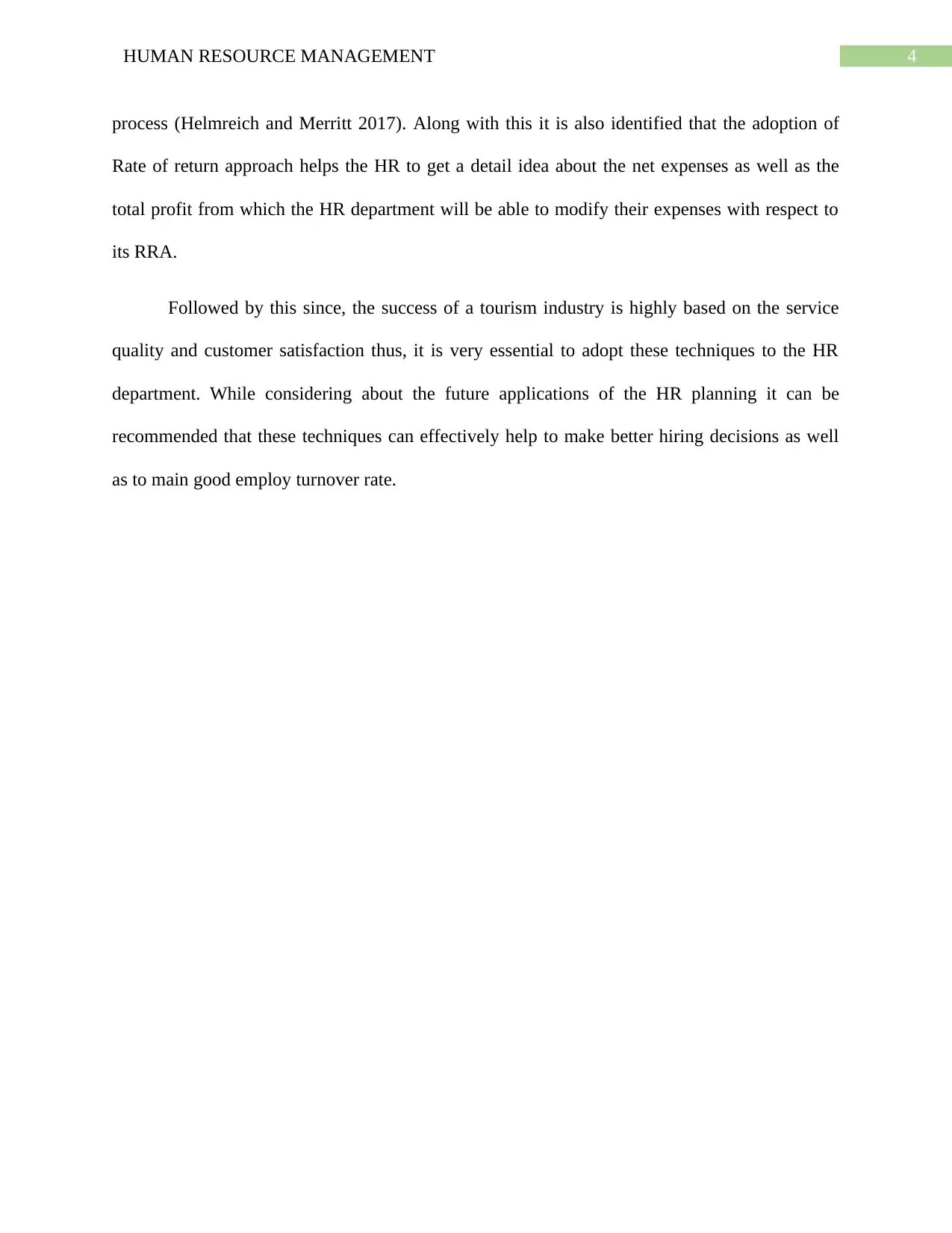
4HUMAN RESOURCE MANAGEMENT
process (Helmreich and Merritt 2017). Along with this it is also identified that the adoption of
Rate of return approach helps the HR to get a detail idea about the net expenses as well as the
total profit from which the HR department will be able to modify their expenses with respect to
its RRA.
Followed by this since, the success of a tourism industry is highly based on the service
quality and customer satisfaction thus, it is very essential to adopt these techniques to the HR
department. While considering about the future applications of the HR planning it can be
recommended that these techniques can effectively help to make better hiring decisions as well
as to main good employ turnover rate.
process (Helmreich and Merritt 2017). Along with this it is also identified that the adoption of
Rate of return approach helps the HR to get a detail idea about the net expenses as well as the
total profit from which the HR department will be able to modify their expenses with respect to
its RRA.
Followed by this since, the success of a tourism industry is highly based on the service
quality and customer satisfaction thus, it is very essential to adopt these techniques to the HR
department. While considering about the future applications of the HR planning it can be
recommended that these techniques can effectively help to make better hiring decisions as well
as to main good employ turnover rate.
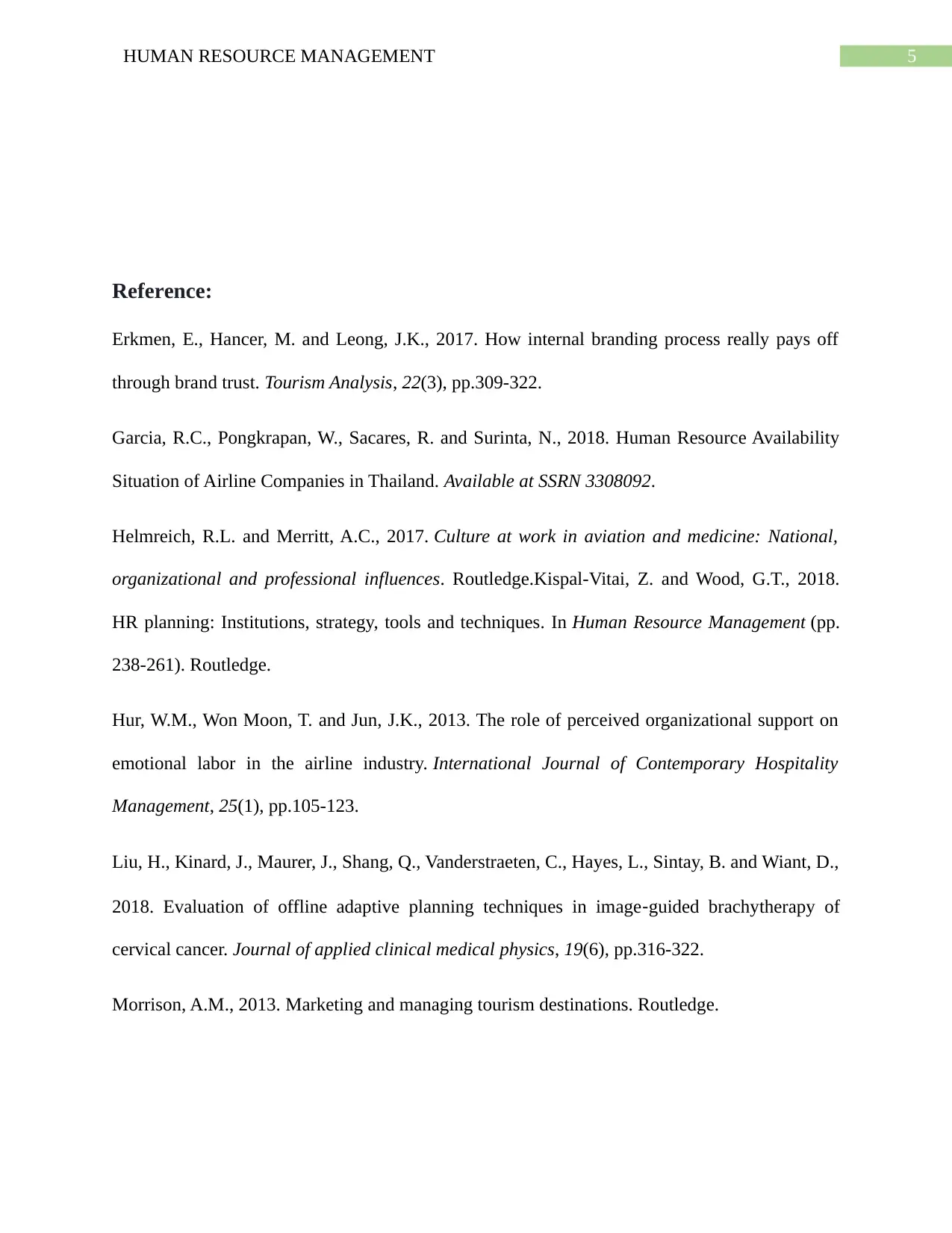
5HUMAN RESOURCE MANAGEMENT
Reference:
Erkmen, E., Hancer, M. and Leong, J.K., 2017. How internal branding process really pays off
through brand trust. Tourism Analysis, 22(3), pp.309-322.
Garcia, R.C., Pongkrapan, W., Sacares, R. and Surinta, N., 2018. Human Resource Availability
Situation of Airline Companies in Thailand. Available at SSRN 3308092.
Helmreich, R.L. and Merritt, A.C., 2017. Culture at work in aviation and medicine: National,
organizational and professional influences. Routledge.Kispal-Vitai, Z. and Wood, G.T., 2018.
HR planning: Institutions, strategy, tools and techniques. In Human Resource Management (pp.
238-261). Routledge.
Hur, W.M., Won Moon, T. and Jun, J.K., 2013. The role of perceived organizational support on
emotional labor in the airline industry. International Journal of Contemporary Hospitality
Management, 25(1), pp.105-123.
Liu, H., Kinard, J., Maurer, J., Shang, Q., Vanderstraeten, C., Hayes, L., Sintay, B. and Wiant, D.,
2018. Evaluation of offline adaptive planning techniques in image‐guided brachytherapy of
cervical cancer. Journal of applied clinical medical physics, 19(6), pp.316-322.
Morrison, A.M., 2013. Marketing and managing tourism destinations. Routledge.
Reference:
Erkmen, E., Hancer, M. and Leong, J.K., 2017. How internal branding process really pays off
through brand trust. Tourism Analysis, 22(3), pp.309-322.
Garcia, R.C., Pongkrapan, W., Sacares, R. and Surinta, N., 2018. Human Resource Availability
Situation of Airline Companies in Thailand. Available at SSRN 3308092.
Helmreich, R.L. and Merritt, A.C., 2017. Culture at work in aviation and medicine: National,
organizational and professional influences. Routledge.Kispal-Vitai, Z. and Wood, G.T., 2018.
HR planning: Institutions, strategy, tools and techniques. In Human Resource Management (pp.
238-261). Routledge.
Hur, W.M., Won Moon, T. and Jun, J.K., 2013. The role of perceived organizational support on
emotional labor in the airline industry. International Journal of Contemporary Hospitality
Management, 25(1), pp.105-123.
Liu, H., Kinard, J., Maurer, J., Shang, Q., Vanderstraeten, C., Hayes, L., Sintay, B. and Wiant, D.,
2018. Evaluation of offline adaptive planning techniques in image‐guided brachytherapy of
cervical cancer. Journal of applied clinical medical physics, 19(6), pp.316-322.
Morrison, A.M., 2013. Marketing and managing tourism destinations. Routledge.
⊘ This is a preview!⊘
Do you want full access?
Subscribe today to unlock all pages.

Trusted by 1+ million students worldwide
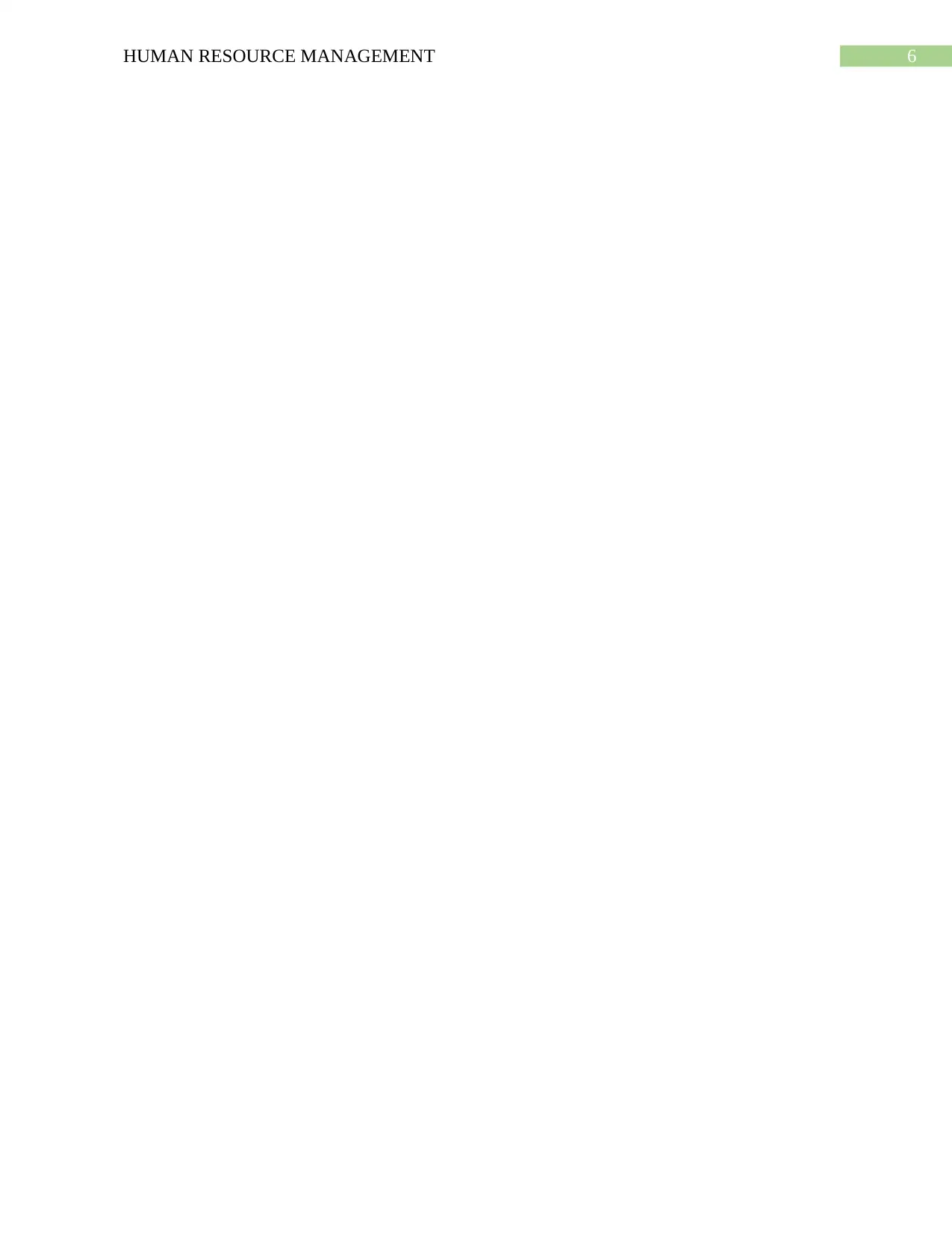
6HUMAN RESOURCE MANAGEMENT
1 out of 7
Related Documents
Your All-in-One AI-Powered Toolkit for Academic Success.
+13062052269
info@desklib.com
Available 24*7 on WhatsApp / Email
![[object Object]](/_next/static/media/star-bottom.7253800d.svg)
Unlock your academic potential
Copyright © 2020–2025 A2Z Services. All Rights Reserved. Developed and managed by ZUCOL.





